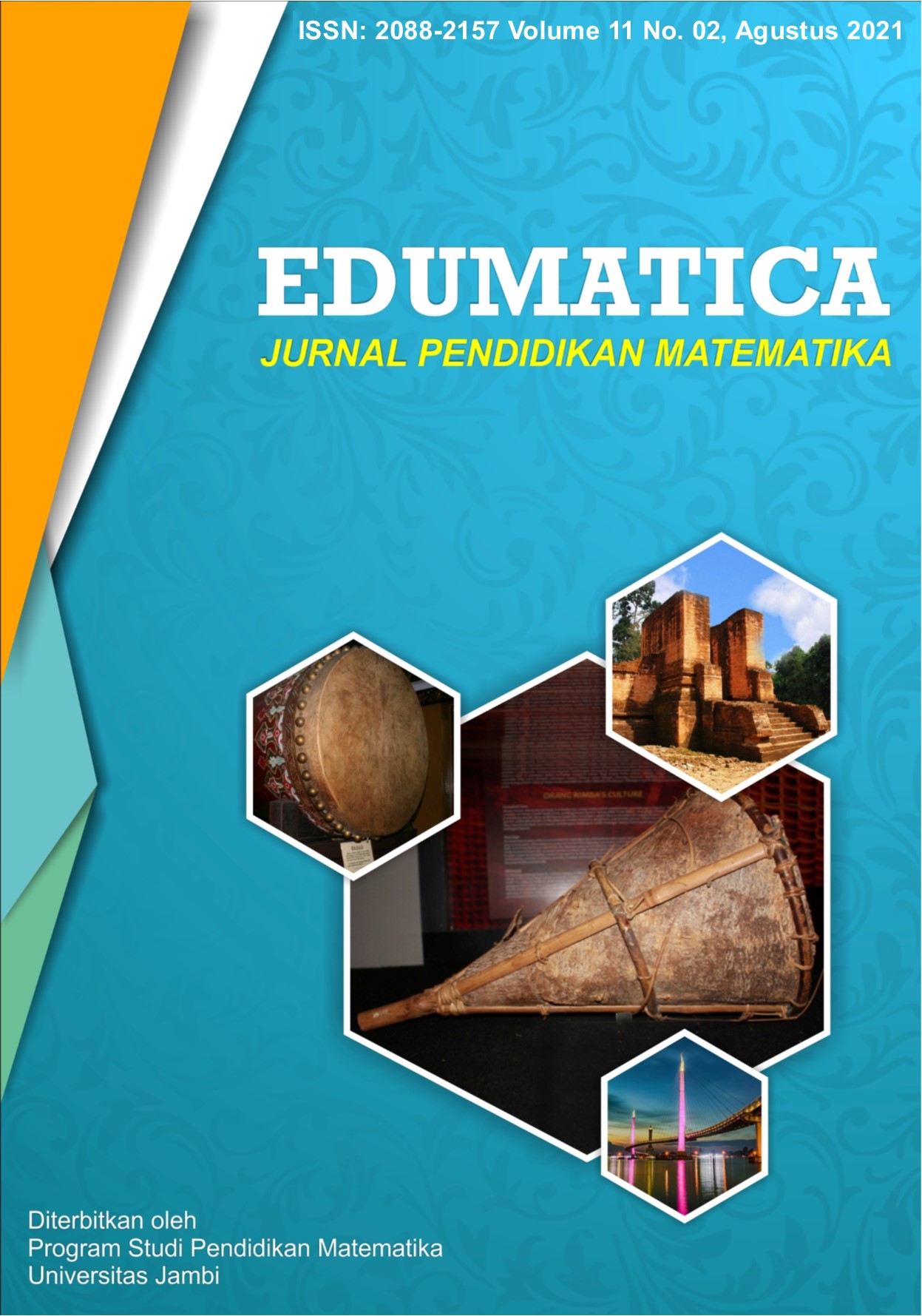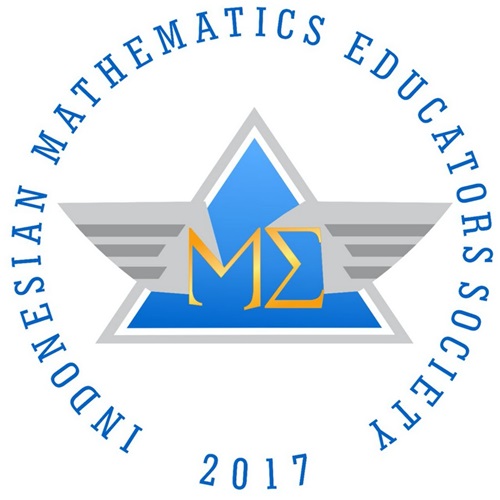Analysis of Students' Mathematics Learning Difficulty Levels in Using Mathematical Principles
DOI:
https://doi.org/10.22437/edumatica.v11i02.11091Keywords:
analysis, mathematics learning difficulty, mathematical principlesAbstract
In the world of education there are still many students who have difficulty learning mathematics. Difficulty learning mathematics is a condition, a person is not able to learn mathematics well. The difficulty in learning mathematics is related in mentioning things that are known and asked for, calculating (counting), and application of formulas. Based on these circumstances, the researcher conducted a study that aims to analyze the difficulties of learning mathematics in using the principles of determinant and inverse matrix material. This learning difficulty was analyzed based on indicators of learning difficulties in mathematics using the principles of (1) calculation errors or algebraic operations, (2) unable to determine relevant data, and (3) unable to apply formulas. This type of research is descriptive qualitative, with the research instruments are tests and interviews. The descriptions of the results of the analysis of the difficulty of learning mathematics in using the principles are: (1) the calculation error indicator is still at a high level criterion, so that the students' numeracy skills still need to be improved, especially in terms of accuracy, accuracy, and caution; (2) the inability to determine relevant data is at the medium level criteria, but this ability can still be improved again by getting used to writing things that are known and asked for to make it easier to solve mathematical problems; and (3) the indicators of not being able to apply the formula are at low level criteria, which are dominated by low-ability students. This difficulty can be minimized by direct mentoring by the teacher and or through peer tutors.
Downloads
References
Apriliawan, A., Gembong, S., & Sanusi, S. (2013). Analisis Kesalahan Penyelesaian Soal Uraian Matematika Siswa MTs pada Pokok Bahasan Unsur-Unsur Lingkaran. JIPM (Jurnal Ilmiah Pendidikan Matematika), 1(2). https://doi.org/10.25273/jipm.v1i2.480
Ardi, Z., Rangka, I. B., Ifdil, I., Suranata, K., Azhar, Z., Daharnis, D., Afdal, A., & Alizamar, A. (2019). Exploring the Elementary Students Learning Difficulties Risks on Mathematics Based on Students Mathematic Anxiety, Mathematics Self-Efficacy and Value Beliefs Using Rasch Measurement. Journal of Physics: Conference Series, 1157(3), 032095. https://doi.org/10.1088/1742-6596/1157/3/032095
Dangnga, M., & Muis, A. (2015). Teori Belajar dan Pembelajaran Inovatif. https://scholar.google.com/scholar?cluster=16827700042778377319&hl=en&oi=scholarr
Fritz, A., Haase, V. G., & Räsänen, P. (2019). International Handbook of Mathematical Learning Difficulties: From the Laboratory to the Classroom. In International Handbook of Mathematical Learning Difficulties: From the Laboratory to the Classroom. Springer International Publishing. https://doi.org/10.1007/978-3-319-97148-3
Hapizah. (2017). Kemampuan Mahasiswa Menyelesaikan Soal Problem-Solving Mata Pelajaran Matematika Tingkat Sekolah Menengah Pertama. Jurnal Pendidikan dan Pembelajaran (JPP), 23(2), 124-131. http://journal.um.ac.id/index.php/pendidikan-dan-pembelajaran/article/view/10163
Hasibuan, E. K. (2018). Analisis Kesulitan Belajar Matematika Siswa pada Pokok Bahasan Bangun Ruang Sisi Datar di SMP Negeri 12 Bandung. AXIOM : Jurnal Pendidikan dan Matematika, 7(1). https://doi.org/10.30821/axiom.v7i1.1766
Hasratuddin. (2014). Pembelajaran Matematika Sekarang dan yang akan Datang Berbasis Karakter. Jurnal Didaktik Matematika, 1(2). http://www.e-repository.unsyiah.ac.id/DM/article/view/2075
Jamal, F. (2014). Analisis Kesulitan Belajar Siswa dalam Mata Pelajaran Matematika pada Materi Peluang Kelas XI IPA SMA. In Jurnal Pendidikan Matematika) (Vol. 1, Issue 1). https://www.ejournal.stkipbbm.ac.id/index.php/mtk/article/view/232
Kusumaningrum, D. S., Arum, S., & Lestari, P. (2019). Analisis Kesulitan Belajar Matematika Diskrit Mahasiswa Teknik Informatika. In PRISMA (Vol. 8, Issue 2). https://doi.org/10.35194/JP.V8I2.717
Pramesti, C. (2019). Analisis Kemampuan Kognitif Mahasiswa pada Mata Kuliah Teori Bilangan. Cakrawala Pendidikan, 23.
Sidik, G. S., & Wakih, A. A. (2020). Kesulitan Belajar Matematika Siswa Sekolah Dasar pada Operasi Hitung Bilangan Bulat. NATURALISTIC : Jurnal Kajian Penelitian Pendidikan dan Pembelajaran, 4(1), 461-470. https://doi.org/10.35568/naturalistic.v4i1.633
Surya, E., & Novriani, M. R. (2017). Analysis of Student Difficulties in Mathematics Problem Solving Ability at MTS SWASTA IRA Medan Comprarison of Mathematics Learning Outcome Student Thaught Using Guided Discovery with Problem Based Learning (PBL) In X Class of Senior High School MAS Nurul. International Journal of Sciences: Basic and Applied Research, 33(3), 63-75. http://gssrr.org/index.php?journal=JournalOfBasicAndApplied
Suryabrata, S. (2013). Metodologi Penelitian. PT Raja Grafindo Persada.
Syarifah, D. H. H., & Richanatus. (2017). Studi Kasus Kesulitan Belajar Matematika pada Remaja. Jurnal Psikologi, 11(1). https://ejournal.up45.ac.id/index.php/psikologi/article/view/109
Wang, G., Du, H., & Liu, Y. (2009). Case Study on Improving High School Students with Learning Difficulties in Mathematics. In Journal of Mathematics Education © Education for All (Vol. 2, Issue 2).
Yusmin, E. (2017). Kesulitan Belajar Siswa pada Pelajaran Matematika (Rangkuman dengan Pendekatan Meta-Ethnography). In Jurnal Visi Ilmu Pendidikan (Vol. 9, Issue 1). https://jurnal.untan.ac.id/index.php/jvip/article/view/24806
Downloads
Published
How to Cite
Issue
Section
License
Copyright (c) 2021 Cicik Pramesti, Ariesandi Prasetya

This work is licensed under a Creative Commons Attribution-NonCommercial-ShareAlike 4.0 International License.







